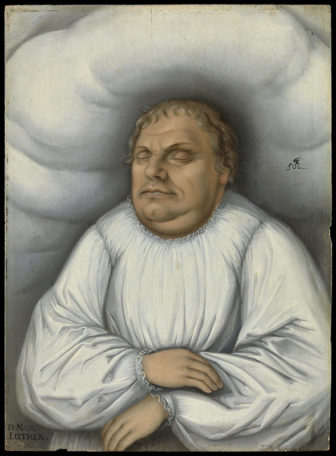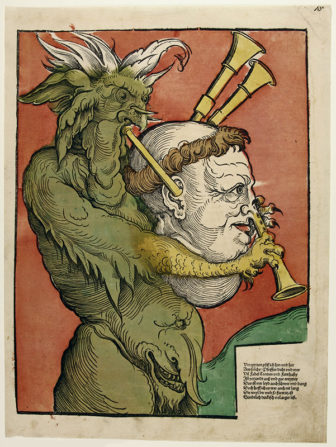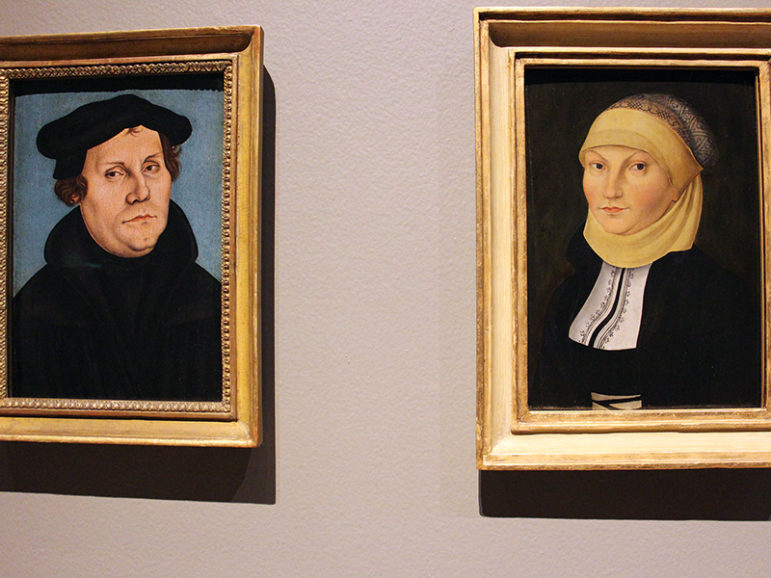MINNEAPOLIS (RNS) When it came to art, Martin Luther was much more interested in music than in the visual arts.
He once called music “half a sacrament” and said, “Next to the Word of God, the noble art of music is the greatest treasure in the world.”
RELATED: Martin Luther as history’s first tweeter? An ongoing legacy, 500 years later
But Luther also recognized images had the power to teach – a powerful form of communication the church could use, said David Morgan, professor and chair of the department of religious studies at Duke University.
“So from the beginning, he defended the use of images,” Morgan said.
[ad number=”1″]
Nearly 500 years later — 499, to be exact — three museums across the United States, in cooperation with four German institutions, are using art once again to communicate the lasting impact of Luther and the Protestant Reformation.

Tom Rassieur, the John E. Andrus III Curator of Prints at the Minneapolis Institute of Art, and Harald Meller, director and state archaeologist at the State Office for Heritage Management and Archaeology Saxony-Anhalt and State Museum of Prehistory in Halle, Germany, speak to the press Oct. 27, 2016, outside the exhibition “Martin Luther: Art and the Reformation” at the Minneapolis Institute of Art in Minneapolis. RNS photo by Emily McFarlan Miller
“Martin Luther: Art and the Reformation” opened at the Minneapolis Institute of Art, or Mia, on Sunday (Oct. 30), ahead of the anniversary of the German monk and scholar nailing his 95 Theses to the Castle Church door on Oct. 31, 1517, in Wittenberg, Germany — the event that sparked the Reformation.
The show will run through Jan. 15, 2017 — shorter than usual for an exhibition at the museum, noted Tom Rassieur, its John E. Andrus III Curator of Prints. But Mia had a “narrow moment of opportunity” to display the pieces as Germany gears up for next year’s “Luther Year,” celebrating the 500th anniversary of the Reformation, the curator said.
“One man, Martin Luther, took a stand that literally shredded the fabric of Europe,” Rassieur said. “It changed theology, it changed politics, it changed society and it changed political boundaries. It gave us a revolution in education, in literacy. There are many, many manifestations of the Reformation which are addressed in this exhibition.”
[ad number=”2″]
Minneapolis was chosen for the largest of three exhibitions organized in partnership with the Luther Memorials Foundation of Saxony-Anhalt, Wittenberg; Deutsches Historisches Museum, Berlin; Foundation Schloss Friedenstein, Gotha; and State Museum of Prehistory, Halle. The others opened earlier this fall in New York and Atlanta.
That’s because of the renown of its art museum and its concentration of Lutherans, according to Harald Meller, director and state archaeologist at the State Office for Heritage Management and Archaeology Saxony-Anhalt and State Museum of Prehistory. Minnesota is home to one of the largest Lutheran populations in the United States: 34 percent of Minnesotans are Lutheran, and 37 percent can trace their ancestry to Germany, according to Thrivent Financial for Lutherans.
Teaching and transitioning

Follower of Lucas Cranach the Elder, “Martin Luther on His Deathbed,” before 1600 © Deutsches Historisches Museum. Photo courtesy of “Martin Luther: Art and the Reformation,” via Minneapolis Institute of Art
“Martin Luther: Art and the Reformation” centers on Luther’s use of art not only as a teaching tool, but also as propaganda. It includes 16 paintings from the studio of Lucas Cranach the Elder, a close friend of Luther’s who created an instantly recognizable image of the reformer, as iconic as any Catholic saint — or any profile photo on social media.
“It was a really fascinating image industry around Luther because he was such a celebrity and people wanted to know what this guy looked like,” said Morgan, who has not yet seen the exhibit. “And then the Catholics picked up on this and started showing him as a demon and a monster because they wanted to counter the propaganda with their visual culture.”
The show also features the Reformation’s impact on art: toppled statues and defaced books as iconoclasts — other Reformers, like Andreas Karlstadt and John Calvin, who believed religious imagery was idolatrous — emerged from the movement, and pictures married with text as the word took precedence in Lutheran theology. The newly restored Gotha Panel Altar Piece from the Workshop of Heinrich Füllmaurer includes 157 panels with illustrations and inscriptions — and biblical references for each.
[ad number=”3”]
“(Luther) said there’s nothing wrong with images as long as you don’t worship them,” Morgan said.

Erhard Schön (attributed), “Demon Playing Monk Bagpipe,” c. 1535 © Foundation Schloss Friedenstein Gotha. Photo courtesy of “Martin Luther: Art and the Reformation,” via Minneapolis Institute of Art
And it shows a world in transition, reeling amid new technology and new ideas.
One example is the pulpit of St. Andrew’s Church in Eisleben, installed in 1518 as Luther introduced greater importance to the sermon in worship and restored as part of the exhibition. It’s where Luther stood as he gave his last sermon in 1546, and it’s covered in Catholic imagery – with nods to the Reformer: St. Martin, his namesake; St. Catherine, the namesake of Luther’s wife, Katharina von Bora; and St. Andrew, the namesake of the church.
“The exhibition is full of monuments of Lutheran objects,” Rassieur said.
“Many of these are the most precious objects in Saxony that reflect Lutheran history, but they also reflect people who are struggling to cope with a changing world. One of the things that I find most interesting in the exhibition is that these are people who were facing new ideas and rapid developments around them just as we are facing today, and they had to figure out how to deal with this.”






